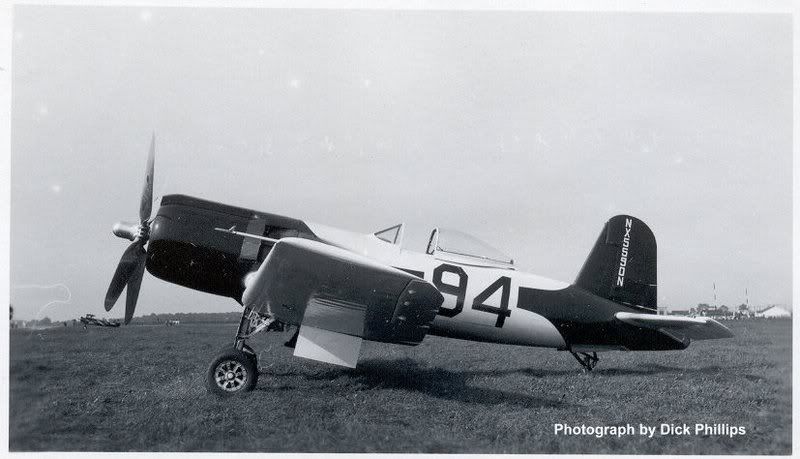Mon Jul 21, 2008 12:33 am
One white blade against the others being darker causes a visual disorientation so you believe the prop is turning slower than it really is, and you then believe the aircraft isn't moving as fast as it really is.
read somewhere a long time ago that TEMPEST and TYPHOON pilots did that during the war to throw off German ground troops
read somewhere a long time ago that TEMPEST and TYPHOON pilots did that during the war to throw off German ground troops
Mon Jul 21, 2008 1:34 am
Thanks for the explanation. I can agree that it's disorienting..I watched Race #57 taxiing out at an airshow a few years ago, and the one white blade made it look really weird.
She's certainly a magnificent bird, with an awsome sound. That's still the only R-4360 I've ever had the pleasure of hearing run.
SN
She's certainly a magnificent bird, with an awsome sound. That's still the only R-4360 I've ever had the pleasure of hearing run.
SN
Mon Jul 21, 2008 5:29 am
i won't dare to spell his name again 
Mon Jul 21, 2008 9:17 am
Great old pictures. Here is one made to look old from last year. I love how Bob wears the old school leather helmet on some flights. It's pretty tough to photoshop out the new ones!!!


Mon Jul 21, 2008 10:52 am
Thanks for the great photos. Now however I have a few questions.
1. Does any one have any more photos of FG-1D N4719C 92081?
2. Does any one have any photos of the following:
a. FG-1D N4716C 67089
b. FG-1D N4717C 92399
These 3 aircraft were registered to Queen City Salvage, Inc. of Charlotte,
NC.
If any has photos of these aircraft could they please post, or send me a PM. Thanks in advance. John Kerr
1. Does any one have any more photos of FG-1D N4719C 92081?
2. Does any one have any photos of the following:
a. FG-1D N4716C 67089
b. FG-1D N4717C 92399
These 3 aircraft were registered to Queen City Salvage, Inc. of Charlotte,
NC.
If any has photos of these aircraft could they please post, or send me a PM. Thanks in advance. John Kerr
Mon Jul 21, 2008 8:15 pm
The current airscoop extension on #57 is the same type that was used on #94 and #74 (after 1947), which is with #74 today.
The "origional" airscoop extension on #57 had the hump to try to ease the downward turn of the air into the carburator. It all but elimited forward visibility on the ground. The origional (humped) was drawned by J. Zeamer and approved by "EHG" of Pratt & Whitney. The drawings are undated and are on Pratt & Whitney titleblocked paper. The scoop entrance area is 85 square inches. The area increases up to the turning section. The turning section has -2- internal vanes, dividing the airflow into -3- cross-sections to turn. The origional elbow was made of .040 Stainless Steel, while the cover was made of .064 (or .069) 35 1/2 H Aluminum.
Cook said that they tried the white blade on a standard Corsair (in Korea) but it didn't have any effect.
May all your bent wings be F2G Corsairs!
Kenn
The "origional" airscoop extension on #57 had the hump to try to ease the downward turn of the air into the carburator. It all but elimited forward visibility on the ground. The origional (humped) was drawned by J. Zeamer and approved by "EHG" of Pratt & Whitney. The drawings are undated and are on Pratt & Whitney titleblocked paper. The scoop entrance area is 85 square inches. The area increases up to the turning section. The turning section has -2- internal vanes, dividing the airflow into -3- cross-sections to turn. The origional elbow was made of .040 Stainless Steel, while the cover was made of .064 (or .069) 35 1/2 H Aluminum.
Cook said that they tried the white blade on a standard Corsair (in Korea) but it didn't have any effect.
May all your bent wings be F2G Corsairs!
Kenn
???
Mon Jul 21, 2008 8:21 pm
Just to note my dad's cousin was a engineer with Hamilton Standard/United Aircraft and designed the prop/blades for the F2G/4360
and also the Wrights on the SA-16 among others. His name was Bob Metty.
and also the Wrights on the SA-16 among others. His name was Bob Metty.
Tue Jul 22, 2008 10:45 am
kennsmithf2g wrote:The current airscoop extension on #57 is the same type that was used on #94 and #74 (after 1947), which is with #74 today.

NX5590N
Last edited by Swiss Mustangs on Tue Jul 22, 2008 11:03 am, edited 1 time in total.
Re: bubble canopy question
Tue Jul 22, 2008 10:58 am
Matt Gunsch wrote:hahnej wrote:I find it kind of interesting that the F2G models (some of them anyway) had bubble canopies and the post war -5, -7, and AU-1's retained the original setup (modified somewhat).
Really only the only fighter that I can think of that didn't convert to the bubble style after it was prototyped.
Wonder why?
all F2G Corsair had bubble canopies. The only Corsair I remember with a modied canopy for racing was the Super Corsair.
The prototype F2G had a standard Birdcage Canopy IIRC.
The XF2G-1 had the bubble which was developed and tested on a FG-1 airframe.
Rich
Tue Jul 22, 2008 2:00 pm
Was #94 in the Warbird Digest article? I don't remember seeing that one before.